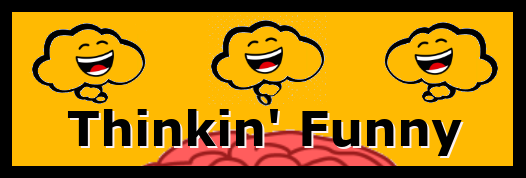Humor is reason gone mad.
- Groucho Marx
Why Do We Laugh?
One of the keys to thinkin’ funny is understanding what causes laughter.
Of course, how laughter’s created is a debatable mystery, and every comedian has an opinion or theory on that.

A couple of Thinkin’ Funny posts ago, I said that the reason we laugh is because we “get” how two incongruent worlds have been cleverly combined.
Here’s another way to express that same idea:
Normal moment + heightened friction + ending with a surprising mental connection = laughter
Here’s another:
Heightened Tension + An Unlikely Release = Laughter
And another:
Identity + Struggle + Discovery + Surprise = Laughter
And still another:
Premise + setup + punchline = laughter
They’re all basically saying the same thing:
To get a laugh, you gotta set up and heighten some tension between two incongruent worlds, then release it in a surprising way. Do that repeatedly (aka “play the game”) and you get even more laughs.
This a simple formula that can get highly complex once you learn and master the rules and then start bending and breaking them.
Beginning humorists tend to use puns to connect incongruent worlds, so let’s start there.

Puns & Homonyms
Puns rely on homonyms to get laughs.
Homonyms are two words spelled the same but with different meanings.
For example:
Simple joke: I have a pet tree. It’s like a pet dog, but the bark is quieter.
World Connector = Homonym: bark, as in a dog’s bark and a tree’s bark.
- Premise: I have a pet tree…
- Setup: It’s like a pet dog, but
- Punchline: the bark is quieter.
Worlds combined: The world of pet dogs + the world of trees
Surprising unlikely connector between those two worlds: bark (it’s both the noise a dog makes and the external surface of a tree)
The normal moment, or premise, establishes that the person has a pet.
The first bit of tension is created by making the pet a tree (we think, what? who has a pet tree, that’s odd…).
Next, that tension is heightened even more in the setup by saying that having a pet tree and pet dog are similar (we think, what? No way, how can that be?)
That tension is released by making a surprising connection between those two worlds, which we do by using the homonym ‘bark,’ which applies to both.
A tree’s bark makes no noise, which is definitely quieter than a dog’s bark.
When our brain realizes the truth of that punchline, or ‘gets’ that the word ‘bark’ could apply to either world, then we smile or chuckle or laugh, depending on how much of a surprise ‘getting’ that connection was for us.

Here’s another basic example using a homonym:
Simple joke: A sandwich walks into a bar. The bartender says, “Sorry, we don’t serve food here.”
World Connector = Homonym: serve, as in ‘the act of a servant’ and ‘to have refreshments available.’
- Premise: A sandwich walks into a bar.
- Setup: The bartender says… (implied here is an expectation of how that moment will end, which is the bar patron getting whatever they are about to order.
- Punchline: “Sorry, we don’t serve food here.”
Worlds combined: world of bars + world of sandwich
The normal moment, or premise, establishes that a customer is walking into a bar.
The first bit of tension is created by having food walking into a bar (We think, what? That’s not normal).
That tension is heightened when the bartender starts an old racist trope, “Sorry, we don’t serve…”
Surprising unlikely connector between those two worlds: serve (it’s both act of delivering something and the idea of having something available).
The tension is released by making a surprise connection between the two worlds of bar and sandwich.
We do this by using the homonym ‘serve’ since it can apply to both: simply serving food (we sell food items) and serving customers (our staff waits on our patrons).
The laugh comes when your brain ‘gets’ the how both definitions of ‘serve’ fit in this case of a bit of food looking to get ‘served.’
When our brain ‘gets’ that, it causes a smile or chuckle or laugh, depending on how surprising that connection is to the person.
As the jokes get more sophisticated, the way the incongruent worlds are combined does, too.
Here’s a joke that’s a bit more complex:

More Complex Joke:
Two hunters are out in the woods when one of them collapses. He’s not breathing, and his eyes are glazed. The other guy whips out his cell phone and calls 911.
“I think my friend is dead!” he yells. “What can I do?”
The operator says, “Calm down. First, let’s make sure he’s dead.”
There’s a silence, then a shot. Back on the phone, the guy says, “OK, now what?”
(pause for laughter?)
Let’s break down this joke into its premise, setup, and punchline:
World Connector = phrase misinterpretation: “make sure he’s dead”
- Premise: While two friends hunt, one collapses so the other calls 911.
- Setup: The operator says, “First, let’s make sure he’s dead.”
- Punchline: “Okay, now what?”
Worlds combined: world of hunting + world of first aid
The normal moment, or premise, establishes that two men are hunting in the woods.
The first bit of tension is created when one hunter collapses (We think, oh no, what happened?).
That tension is heightened with more details on his condition, “He’s not breathing, and his eyes are glazed” (we think, uh oh, this guy could die).
That tension is further heightened when there is silence, then a gunshot.
Surprising unlikely connector between those two worlds: in the world of hunting, “make sure he’s dead” means to put the wounded beast out of its misery, whereas in the world of first aid, “make sure he’s dead” means to check his vitals for a pulse in case he’s still alive.
The tension is released when we “get” that surprise connection, that because that phrase means two different things, the hunter misunderstood the 911 operator’s instructions and shot his friend dead.
See how that joke uses the same underlying format but in a much more complex way.
Regardless of a joke’s clever packaging, with few exceptions it usually comes down to that same formula:
Take a normal moment, add and heightening some friction to it with an incongruent world, and then end with a surprising mental connection between those two seemingly unrelated words.
We’ll keep going over that idea in future blogs so it starts to sink in even deeper for you.
Again, once you learn it, it’s a simple game that can get highly complex as you learn the rules and start bending and even breaking them.

Quick reminder – The goal of this blog is to break down humor in order to help you better understand how this entire process works.
That way you can start to better develop and flex your own funny muscle which everyone has.
Next, let’s get into some more examples of the types of clever connectors that funny people like to use.
So far we’ve looked at homonyms and phrase misinterpretation, but there are many more that we will begin to look at more closely.
Until then,
Mike
Get the free FUNNY MUSCLE Newsletter:
Plus you’ll also get…
- Top-10 Mistakes Unfunny People Make – a strong Funny Muscle avoids the list.
- 5 Surefire Ways to Make Your Next Speech Funnier – get laughs instead of yawns.
- 3 Humor Heightening Devices – pro comics use these to get bigger laughs.
Just ‘click’ and enter a valid email address (then confirm it!) and you’ll get the free newsletter and your funny giveaways.
Then get ready to enjoy some laughs!

![You are currently viewing THINKIN’ FUNNY [5]: Premise, Setup, and Punchline](http://mike-lukas.com/wp-content/uploads/2021/06/Laugh.jpg)



![Read more about the article THINKIN’ FUNNY [4]: Difference Between Saying Funny Things and Saying Things Funny](http://mike-lukas.com/wp-content/uploads/2021/06/Don-Rickles-300x250.jpg)